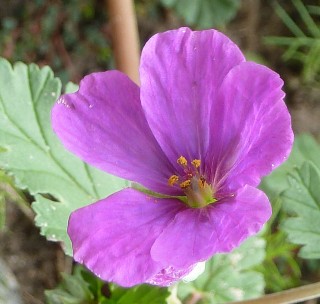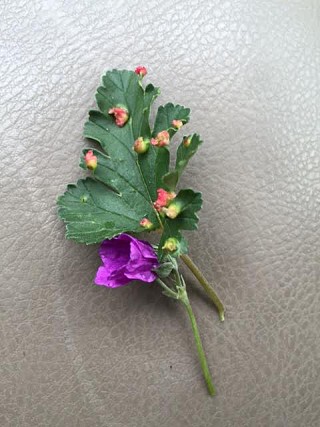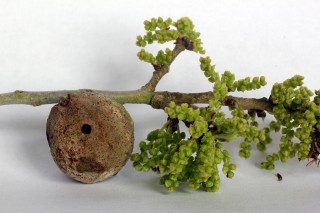
The Texas Stork’s-bill is a small wildflower with a big punch of color. The one-inch wide blossoms are on low-growing stems so you must get down on your knees to see them well. Al Past Photo.
3/21/2015 – Tiny Wildflowers Host a Surprise
The wildflower season has arrived. We are beginning to see swaths of golden Huisache Daisies, fields of stately Bluebonnets, and flashes of flaming Indian Paintbrushes. But there are lots of tiny little flowers to catch our attention, too. You just need to look down.
One of the prettiest little flowers is the Texas Stork’s-bill. This plant is in the Geranium Family and it loves our calcareous soils. Chances are you have one just outside your door! But Texas Stork’s-bill is low-growing and to get a good look at it, you will probably have to kneel. Or else have a young child find it for you.
My friend Tess had her two-year-old son with her when they spotted a pretty purple flower in the Cadiz Baptist Churchyard. The flower was only about one inch across and had five delicate petals which only last about a day. However, what fascinated her even more were the Stork’s-bill’s leaves: They were sporting tiny pink rosebuds!

Texas Stork’s-bill sometimes has funny little “rosebuds” on its leaves. These are galls, patches of abnormal plant tissue, caused by an insect. The insect lays its eggs in the leaves and the plant responds by producing the gall around the eggs. The gall protects and feeds the larvae while they grow. Tess Thornton Photo.
At least that is what they looked like. An Internet search led us to the truth. The “rosebuds” were actually galls. A gall is an abnormal plant growth usually induced by the egg-laying or feeding behavior of an insect or mite. The damage, or possibly the salivary secretions of the insect/mite, causes the plant to produce hormones that initiate localized growth of plant tissue. This gall, a lump of abnormal tissue, often houses (and feeds) the larvae. Eventually, the larvae emerge from the gall as adult insects or mites.
I cut open one of the galls on the Stork’s-bill and looked inside it with a magnifier. Sure enough, there was a tiny larva of some kind in there. It wasn’t moving so perhaps picking the leaf had cut off its food supply. Or it could have been parasitized by another insect.

Many kinds of plants can have galls. One of the most common is the oak gall. Our south Texas Live Oaks frequently bear the spherical structures. This is the time of year when Live Oaks are leafless so it is a good time to look for oak galls. Note the small, round exit hole on the gall. This is where the new adult wasp made its escape. Robert Benson Photo.
Double parasitism like this is a peculiar relationship. The gall-forming insect first parasitizes the plant. Then a tiny wasp parasitizes the first insect’s offspring inside the gall. I can’t help but think that the gall’s shape and color are a signal for the wasp. It instinctively knows that the gall holds a larva victim for its own babies to feed on. Thus the parasite is parasitized!
This reminds me of an old rhyme which I will paraphrase here.
“Little fleas have littler fleas,
Upon their backs to bite them.
And so it goes, and so it goes,
On ad infinitum!”
Many kinds of plants can have galls. Hackberry trees can have nipple-like growths on their leaves in spring. Roses can get bud and flower galls that look like something from outer space! And twig and stem galls also occur.
You are probably familiar with the common oak gall. These galls are perfectly spherical and have a hard shell. The Gall Wasp induces the galls to form by laying its eggs on the twigs of many oak species. Right now is a good time to find oak galls on Live Oaks because the trees are temporarily leafless. The galls can persist for two to four years after the adult Gall Wasp leaves. You can tell if an oak gall is empty because there will be a small round hole where the wasp drilled its way out. These empty galls serve as temporary homes for many beneficial insects and spiders long after the wasp’s exit. And the oak galls do no real damage to the tree.
There are many amazing relationships in nature. They all start out with a plant. The plant makes food for itself and for any organism that feeds on it. Those organisms become food for other creatures and then those creatures are preyed upon by others. Eventually all living things die and return to the soil as nutrients. Those nutrients are absorbed by the roots of plants and the cycle begins again. It really is “the circle of life.”
So take time this spring to look closely at tiny wildflowers and weirder things like galls. They are all part of the wonderful web of life.
If you would like to offer comments, please click through to the discussion page
